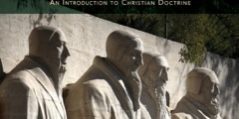
Historical Theology
The following review is from the October issue of Credo Magazine, “The Living Word.”
Historical Theology: An Introduction to Christian Doctrine. By Gregg R. Allison. Grand Rapids: Zondervan, 2011.
Reviewed by Chris Cooper
Is evangelical theology an historical theology simultaneously rooted in two thousand years of Christian history and the sacred writings of the Old and New Testaments? Or, does evangelical theology represent a significant shift away from an older Christian heritage? In Historical Theology: An Introduction to Christian Doctrine, Gregg R. Allison places an entire body of evangelical doctrine directly under the tutelage of historical and biblical Christianity, arguing for the former rather than the latter. Allison serves as Professor of Christian Theology at The Southern Baptist Theological Seminary in Louisville, KY, received his PhD from Trinity Evangelical Divinity School, and, with this volume, proves that he was the right choice to write a companion text to Wayne Grudem’s Systematic Theology: An Introduction to Biblical Doctrine. The fruit of many years of labor, Allison’s Historical Theology will serve as more than a companion to Grudem’s text, equipping pastors, students, and theologically conscience laypeople with an invaluable resource to encourage them along in their historical faith for many years to come.
A unique, beneficial feature of the book is its topical-chronological layout. Rather than highlight important doctrines while treading through the ever-lengthening and complicated timeline of Christian history, Allison structures the book according to specific doctrines then traces the development of those doctrines as they evolved in the course of the church’s history. In fact, when looking at the table of contents, the work purposively bears a striking resemblance to Wayne Grudem’s Systematic Theology. Both works breakdown into the following seven parts: the Doctrine of the Word of God, the Doctrine of God, the Doctrine of Humanity, the Doctrines of Christ and the Holy Spirit, the Doctrine of the Application of Redemption, the Doctrine of the Church, and the Doctrine of the Future. This topical-chronological feature makes it a useful companion to Grudem’s work, but, more than that, it serves as the books most practical attribute for pastors, students, and laypeople. Because each chapter highlights specific doctrines and then traces them through important periods of Christian history from the New Testament to the present day, each chapter stands alone, making the book an important resource that does not have to be read from cover to cover and that is probably most useful when it is not. Although this approach led Allison to repeat himself a number of times in various chapters concerning important movements and their significance for similar doctrines (e.g. Allison addresses Arianism when discussing the Trinity and again when addressing the Person of Christ), repetition is a worthy sacrifice in a book that should serve as a handy, oft-used resource for pastors teaching or preaching upon specific doctrines.
Allison’s Historical Theology also serves as an excellent starting point for students hoping to take a deeper look at a particular doctrine. Although the book does not conclude with a bibliography, each chapter serves as an invaluable research tool for theological students, providing footnotes rich with critical primary sources essential for an understanding of a doctrine’s development through varying stages in Christian history. For instance, if a student hoped to discover the key figures and works important for the development of a particular doctrine during the reformation and post-reformation period, all he would have to do is go to the chapter covering the doctrine and look at the section on the reformation and post-reformation. There, the student would find not only an outline of the important persons and works during this period, but also footnotes referencing the critical editions of those works and many explanatory notes providing further information concerning context.
Another helpful characteristic of Allison’s book, making it an important resource for theologically conscience laypeople, is its brief and easy to read chapters. At first glance, the size of the book will make it appear like a rather daunting read to the average layperson, student, and even pastor, but when one considers the fact that Allison covers thirty-three different topics in seven sections it becomes clear that Allison packs a great deal of useful information into rather small, easy-to-handle packages. Along with brief chapters, Allison’s book is clear to the serious layperson, because Allison does not assume that all of his readers have a knowledge of difficult theological terms and because Allison provides a glossary at the conclusion of his work covering church leaders, writings, and movements mentioned in the book.
If Allison hoped that Historical Theology would be a worthy companion to Grudem’s Systematic Theology that would benefit students and all Christians desirous to learn the history of Christian doctrine, then he has achieved this goal and more. Historical Theology stands as an important resource with a unique structure that will aid pastors, students, and laypeople time and again as they begin or continue their exciting journey into the history of the Christian faith.
Did you enjoy this review? Read others like it in the October issue of Credo Magazine!
[issuu width=420 height=231 backgroundColor=%23222222 documentId=111004125903-7a9245a15ca1450ba2e83e5f97a58fd5 name=the_living_word-oct_2011 username=credomagazine tag=evangelicals unit=px id=a9f431c1-edfa-8fbd-5a02-49600bf61ac9 v=2]
To view the publication click here

